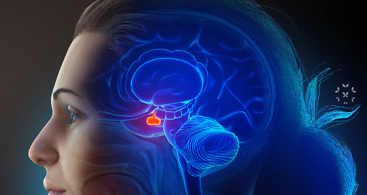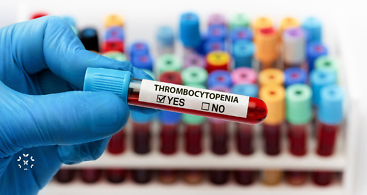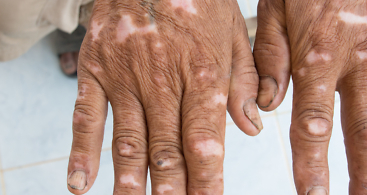Overlap Diseases
Brain and Nervous System, Brain Fog, Comorbidities, Depression, Emotional Health, Fatigue, Invisible Illness, Nervous System, Overlap Diseases, Symptoms, Systemic Lupus Erythematosus (SLE)
Lupus and Seasonal Affective Disorder (SAD)
Seasonal affective disorder (SAD), sometimes called, the “winter blues,” can affect almost anyone this time of year. However, this form of depression can be particularly challenging for those living with lupus. Read on to find out more about the complex relationship between SAD and lupus, and learn some simple ways to “brighten” one’s outlook! Introduction…
Autoimmune Diseases, Biology of Autoimmunity, Blog, Human Biology, Overlap Diseases
Lupus and Autoimmune Hypophysitis
The pituitary is the most important endocrine gland in your body and autoimmune hypophysitis, though rare, is a condition that can dramatically affect your health and your life with lupus. How? Read on to find out! The 30-second Overview Your Pituitary – A Quick Overview Autoimmune Hypophysitis – A Quick Overview Autoimmune Hypophysitis and Lupus…
Antiphospholipid Syndrome, Autoimmune Diseases, Biology of Autoimmunity, Blood Disorders, Circulatory System, Overlap Diseases, Risks Associated with Lupus, Symptoms, Systemic Lupus Erythematosus (SLE)
Lupus and Thrombocytopenia
Blood disorders can be a common complication of living with lupus. One of the most common is called thrombocytopenia – a low platelet count. Thrombocytopenia affects between 20% and 40% of those with SLE and is a good indicator of how life-threating lupus can be. So, it is worth learning more about it! Introduction Thrombocytopenia…
About Lupus, Featured, General Information, Living with Lupus, Lupus Awareness, Overlap Diseases, Raynaud's, Scleroderma, Symptoms
Scleroderma and Lupus
Scleroderma is one of the most common “overlap diseases” for those living with lupus, with about 20% of those with scleroderma also having lupus. Learn about the complexities of scleroderma including its symptoms, possible complications and the most common ways to manage this autoimmune disease. Introduction Types of Scleroderma Symptoms of Scleroderma Causes of Scleroderma…
Human Biology, Mixed Connective Tissue Disease, Overlap Diseases, Pain
Mixed Connective Tissue Disease (MCTD) and Lupus
Mixed Connective Tissue Disease is one of the most complicated conditions to diagnose and treat, especially as it often mimics the symptoms of lupus. This article sheds some light on this misunderstood condition. Introduction Mixed Connective Tissue Disease (MCTD) Is MCTD an overlap disease of lupus? What causes MCTD? Antibody Profile of MCTD Symptoms of…
About Lupus, Coping With Lupus, Featured, Mixed Connective Tissue Disease, Overlap Diseases, Raynaud's, Rheumatoid Arthritis, Scleroderma, Sjogren's
Lupus Overlap Diseases and Overlap Syndrome
As an individual with lupus, you may find yourself managing additional autoimmune and connective tissue diseases. This article provides a brief overview of these conditions collectively known as lupus overlap diseases and overlap syndrome. Introduction Rheumatoid Arthritis Sjögren’s Syndrome Raynaud’s Phenomenon Scleroderma Mixed Connective Tissue Disease Overlap Syndrome In Conclusion Introduction Several autoimmune, rheumatic and…
About Lupus, Featured, General Information, Living with Lupus, Overlap Diseases, Uncategorized
Epstein-Barr Virus (EBV) and Lupus
This article examines the relationship between the Epstein-Barr virus (EBV) and the development of lupus. Introduction Who is at risk, and what causes EBV? What are the Symptoms of EBV? How is EBV diagnosed and treated? What is the relationship between EBV and lupus? In Conclusion Introduction Epstein-Barr virus (EBV) is a relatively common…
Blog, Fibromyalgia, Overlap Diseases, Pain, Raynaud's, Rheumatoid Arthritis, Symptoms
Pain, Pain, Go Away – The Chronic Pain of Lupus
With lupus, pain can hit any part of the body and at any time, and chronic pain can make day-to-day life difficult. So, what can you do? Read on to learn more about the many kinds of pain associated with lupus, how they are diagnosed and what can be done to treat them. . Why…
Antiphospholipid Syndrome, Autoimmune Diseases, Blog, Featured, General Information, Invisible Illness, Overlap Diseases
Lupus and Antiphospholipid Syndrome
A lupus diagnosis can be confusing and scary enough, let alone being diagnosed with antiphospholipid syndrome as well. Learn about this condition that affects up to 50% of individuals with SLE. . Introduction Signs and Symptoms of Antiphospholipid Syndrome Antiphospholipid Syndrome Causes Antibody Profile of Antiphospholipid Syndrome Diagnosing and Treating Antiphospolipid Syndrome Complications of Antiphospholipid…
Blog, Myositis, Overlap Diseases
Myositis and Lupus
SLE can cause inflammation in all areas of the body. When it directly damages muscle tissue, we call it myositis, a serious condition that causes pain and weakness, sometimes rashes and affects a surprising number of those living with lupus. Read on to find out more about myositis – its causes, diagnosis and treatment. Contents: What…











